Após anos criando sites WordPress, aprendemos como é importante ter uma configuração local do WordPress em seu computador.
Ter o WordPress em sua máquina pessoal permite que você experimente novos recursos sem arriscar seu site ao vivo, mergulhe fundo no desenvolvimento do WordPress e até mesmo crie sites inteiros antes de eles entrarem no ar. É como ter uma caixa de areia particular para todos os seus projetos do WordPress.
Se você é um usuário do Windows, há várias maneiras de configurar o WordPress localmente. Mas reduzimos a lista para os dois métodos mais fáceis. Neste guia, mostraremos como instalar facilmente o WordPress em um computador com Windows, independentemente da versão que estiver usando.
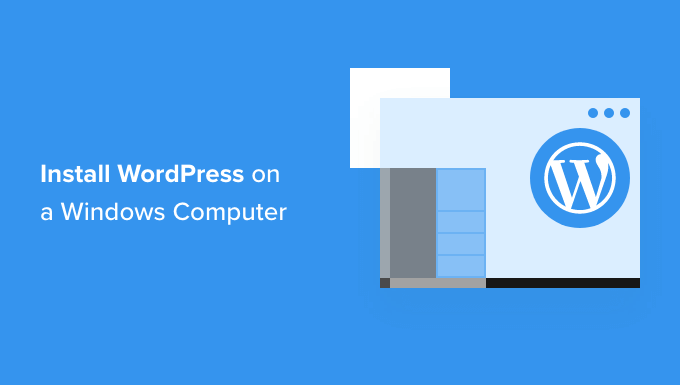
Por que você deve instalar o WordPress no Windows?
Se você for usuário do Windows, a instalação do WordPress localmente no seu computador oferece vários benefícios.
Uma instalação local do WordPress cria um ambiente de teste que não afeta seu site ativo. Essa configuração, geralmente chamada de servidor local ou localhost, é seu playground pessoal para o WordPress.
Os desenvolvedores do WordPress usam regularmente instalações locais para seu trabalho. Por exemplo, eles podem usá-las para experimentar novos plugins ou temas ou testar o site antes de atualizar para o editor de blocos Gutenberg.
Mas isso não é apenas para os profissionais. Se você é novo no WordPress, uma configuração local é perfeita para aprender. Você pode explorar recursos, testar temas e plug-ins e fazer experimentos livremente sem se preocupar em danificar um site ativo.
É importante observar que, quando você instala o WordPress localmente no Windows, somente você pode ver o site. Se quiser criar um site público, você precisará de um nome de domínio e de hospedagem na Web.
Agora, tecnicamente, você pode instalar o WordPress no Windows usando o XAMPP, e já escrevemos um tutorial sobre isso.
Dito isso, descobrimos duas maneiras ainda mais simples do que o XAMPP para configurar um ambiente local do WordPress, o que as torna excelentes para iniciantes ou usuários que precisam criar um site local rapidamente. Você pode clicar no link abaixo para avançar para qualquer método de seu interesse:
Método 1: Instalar o WordPress no Windows usando o Studio (rápido e simples)
Para o primeiro método, usaremos o Studio. É um software WordPress local criado pela Automattic, a empresa que gerencia e administra o WordPress.com, que é um construtor de sites baseado no software WordPress.
Falaremos sobre esse método primeiro porque ele é muito mais rápido e simples de seguir, o que o torna perfeito para iniciantes.
Primeiro, você precisa abrir o site Studio by WordPress.com. Em seguida, clique no botão “Download for Windows”.

Depois de fazer isso, basta abrir o arquivo baixado para iniciar a instalação.
Uma janela pop-up será exibida, mostrando que o aplicativo está sendo instalado.
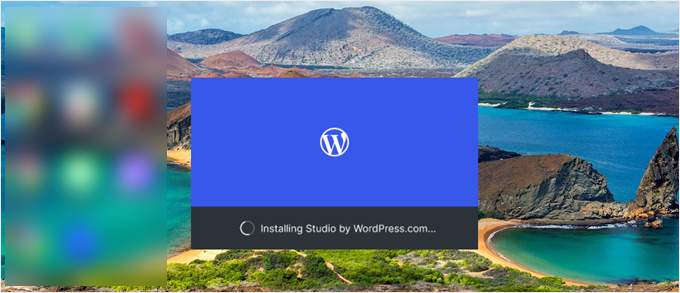
Com isso feito, você pode adicionar seu primeiro site.
Para fazer isso, basta digitar o nome do novo site local do WordPress e clicar em “Adicionar site”. Você pode nomear o site como quiser, desde que isso ajude a identificá-lo facilmente.
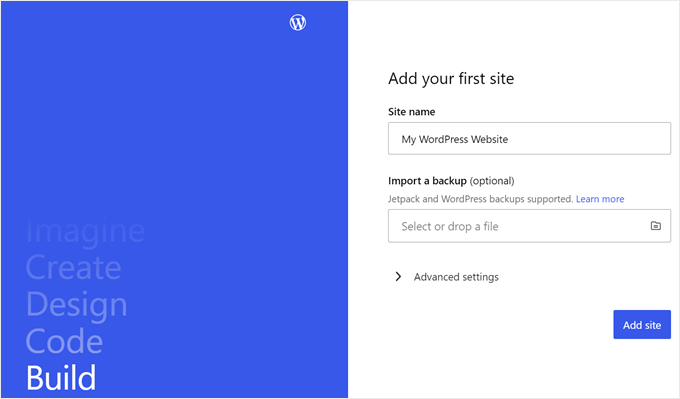
Agora você deve ver o painel do site local do WordPress.
Para acessar o painel do WordPress e editar o site, basta clicar no botão “Iniciar” no canto superior direito. Isso tornará seu site local acessível em seu computador.
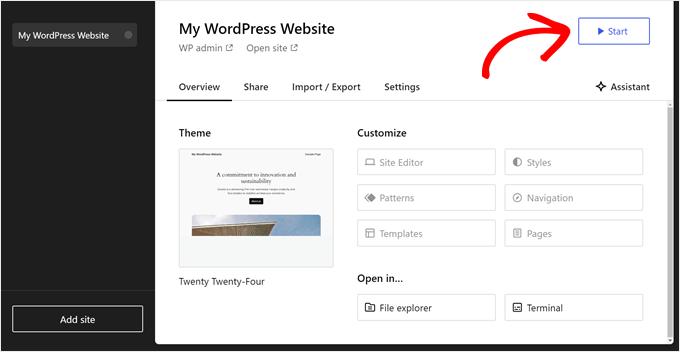
Quando o botão “Start” (Iniciar) mudar para “Running” (Em execução), você poderá clicar no link “WP Admin” (Administração do WP) no canto superior esquerdo da página.
Isso o levará à página de administração local do WordPress.

E isso é praticamente tudo para a configuração. Vamos explorar as outras configurações que podem ser necessárias à medida que você cria seu site local.
Como você pode ver na guia “Overview” (Visão geral), é possível acessar imediatamente o menu do editor de site completo do WordPress diretamente do painel do Studio. Você também pode clicar em “File explorer” (Explorador de arquivos) para abrir as pastas e os arquivos do seu site WordPress e clicar em “Terminal” para gerenciar seu site usando o WP-CLI.
Se você mudar para a guia “Compartilhar”, poderá fazer login na sua conta do WordPress.com, clonar seu site local e carregá-lo nos servidores do WordPress.com. Isso tornará o site clonado temporariamente on-line, o que é útil para compartilhar sites de demonstração com seus clientes ou membros da equipe.
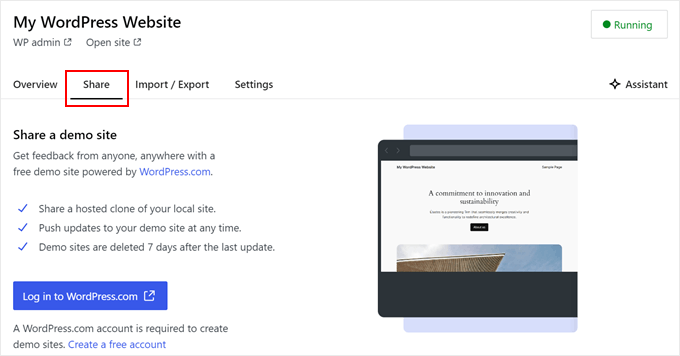
Às vezes, você pode querer fazer login no seu site local diretamente pelo navegador em vez de usar o Studio. Nesse caso, você precisa saber suas credenciais de wp-admin.
Para encontrá-los, vá para a guia “Configurações” e encontre o nome de usuário, a senha e o URL de login do administrador do WordPress.
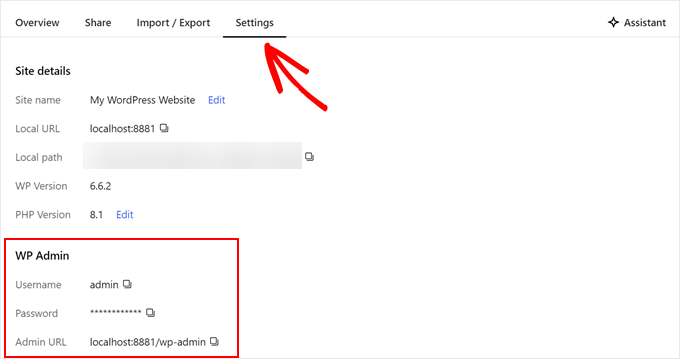
Outro recurso interessante do Studio é o chatbot de IA incorporado, com o qual você pode se comunicar clicando no botão “Assistant”.
Aqui, você pode pedir ajuda ao Studio em tarefas como atualizar todos os seus plug-ins de uma só vez, atualizar a versão principal do WordPress ou criar código para um bloco personalizado.

Quando terminar de trabalhar em seu site local, basta passar o mouse sobre o botão “Running” (Em execução) no canto superior direito até que ele diga “Stop” (Parar).
Em seguida, clique no botão para interromper o site.

Uma desvantagem do Studio é que você não pode configurar o ambiente do WordPress a seu gosto. Isso significa que você precisa usar a versão do PHP, o servidor da Web e o banco de dados que foram pré-selecionados para você.
Isso pode ser uma desvantagem se você precisar testar seu site ou plug-in com configurações de servidor específicas.
Se precisar de mais controle sobre o ambiente local do WordPress ou se precisar combinar sua configuração local com uma configuração específica de servidor ativo, confira o próximo método usando o Local WP.
Método 2: Instalar o WordPress no Windows usando o WP local (mais personalizável)
Primeiro, você precisa fazer o download e instalar o software Local WP em seu computador Windows. Basta acessar o site do Local WP e clicar no botão “Download for Free”.
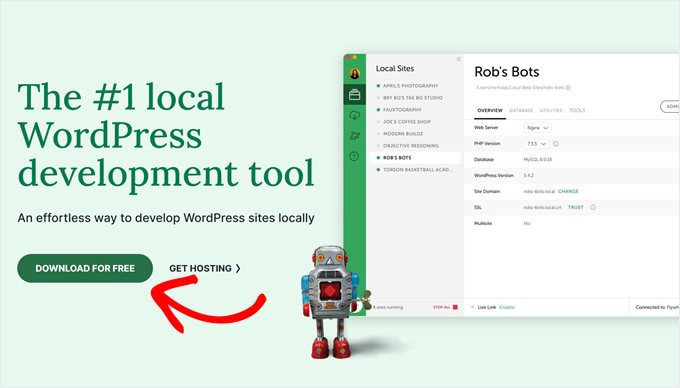
Depois disso, será exibida uma janela pop-up na qual você precisará selecionar a plataforma. Vá em frente e escolha “Windows” no menu suspenso.
Em seguida, insira seus dados, como nome e sobrenome, endereço de e-mail profissional e número de telefone para fazer o download do software.

Depois de inserir os detalhes, basta clicar no botão “Get it Now”.
Depois disso, o software será baixado automaticamente em seu computador. Caso contrário, você pode clicar no link “clique aqui” para iniciar o download.

Depois que o arquivo for baixado, inicie o assistente de configuração.
Agora, você precisará selecionar se deseja instalar o software para todos os usuários ou apenas para você.
Depois de selecionar uma opção, clique no botão “Next” (Avançar).
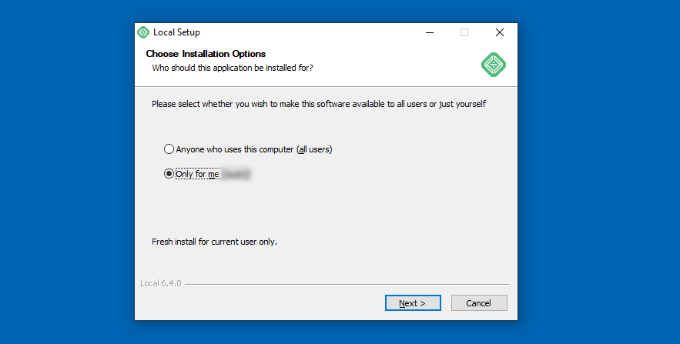
Na próxima etapa, você pode selecionar a “Pasta de destino” onde o software será instalado.
Basta clicar no botão “Procurar” para definir o caminho e, em seguida, clicar no botão “Instalar”.
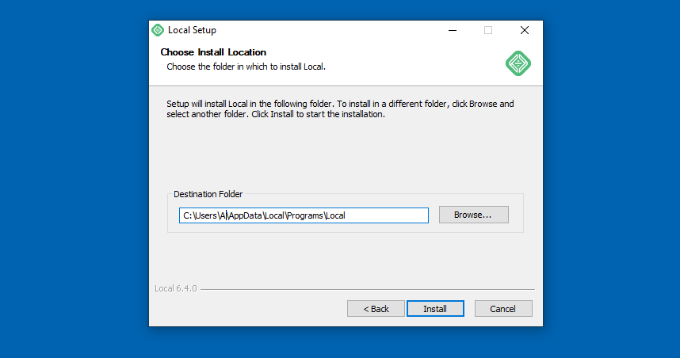
O software Local WP será instalado em seu computador Windows.
Depois de concluído, você pode marcar a caixa de seleção “Run Local” (Executar local) e clicar no botão “Finish” (Concluir) no assistente de configuração.
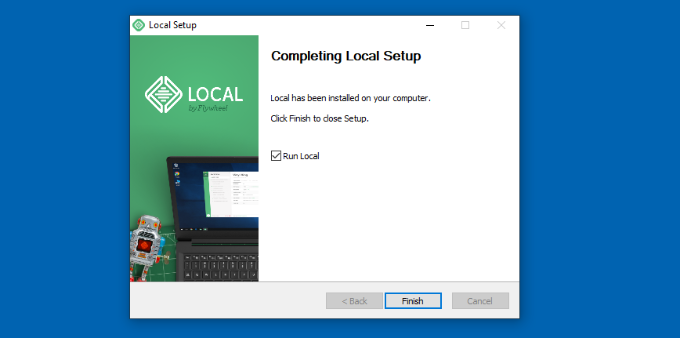
O software será iniciado em seu dispositivo Windows.
A próxima etapa é adicionar um novo site local. Para fazer isso, basta clicar no botão de adição “+” na parte inferior.
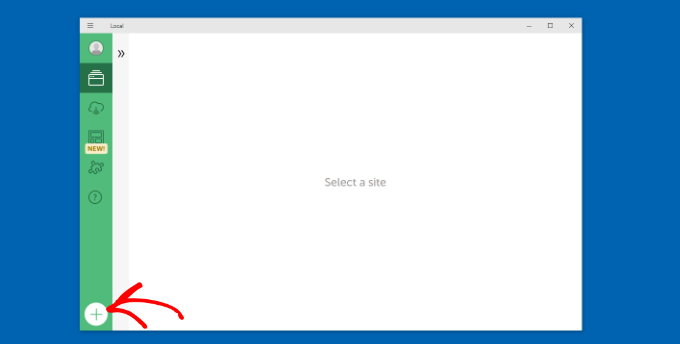
Depois disso, você pode criar um site no software Local.
Selecione a opção “Criar um novo site” e clique no botão “Continuar”. Também há opções para criar o site a partir de um projeto ou de um arquivo de site existente, mas vamos escolher a primeira opção para fins de demonstração.

Em seguida, você pode inserir um nome para seu site local, como “My WordPress Website”.
Há também opções avançadas em que você pode inserir o domínio do site local e o caminho do site local. Por padrão, o domínio usará o título do seu site, mas separado por traços.
Quando terminar, basta clicar no botão “Continue” (Continuar).

Depois disso, você precisará escolher um ambiente para seu site local.
Você pode usar o ambiente “Preferred”, no qual o software selecionará automaticamente a versão do PHP, o servidor da Web e a versão do MySQL. Por outro lado, você também pode selecionar “Custom” (Personalizado) e inserir os detalhes do ambiente.
O Local WP oferece as versões mais recentes do PHP. Quanto ao servidor da Web, você pode escolher entre Nginx ou Apache. Você também pode escolher entre MySQL ou MariaDB para os bancos de dados.
Observe que algumas versões de PHP, servidor da Web e banco de dados exigem o download de algumas dependências para que funcionem corretamente.
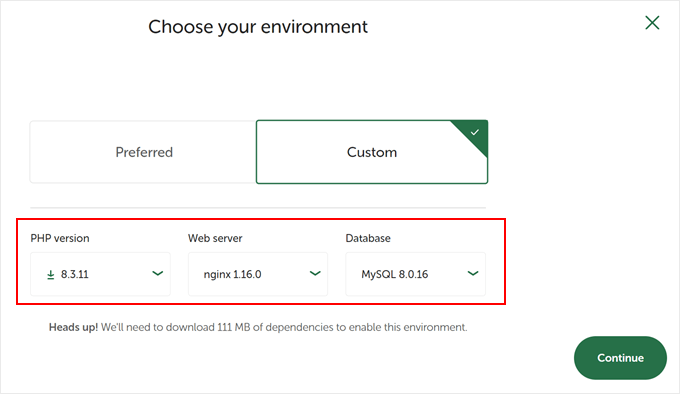
Em seguida, você pode inserir um nome de usuário e uma senha do WordPress para o seu site local. Além disso, há também uma opção para escolher um endereço de e-mail do WordPress no qual você receberá todas as notificações por e-mail.
Além disso, há uma opção avançada em que o software perguntará se você tem uma rede WordPress multisite. Caso contrário, basta clicar em “Não”.
Depois de inserir esses detalhes, basta clicar no botão “Add Site”.
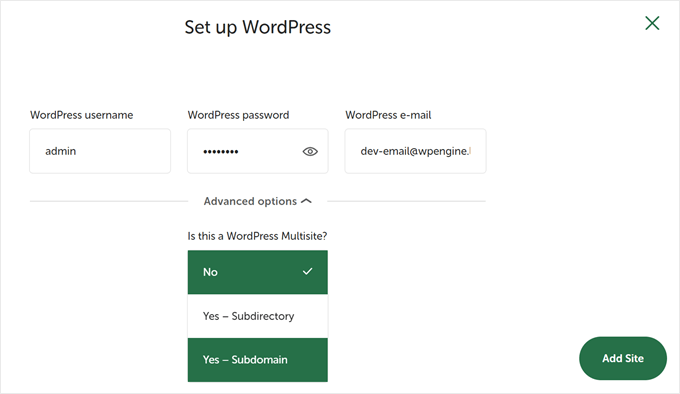
O software agora instalará o WordPress e configurará seu site.
Para iniciar o site local, clique no botão “Start site” (Iniciar site) no canto superior direito.
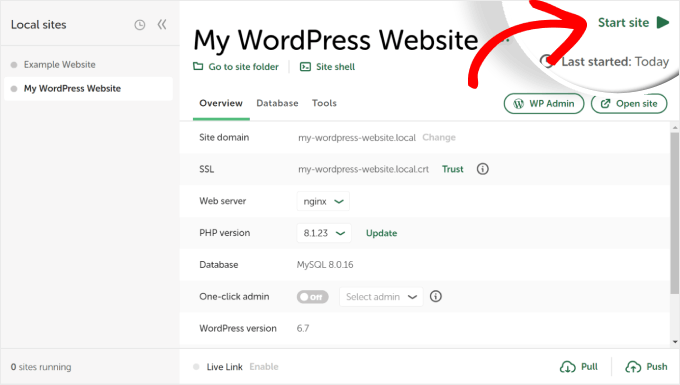
Em seguida, clique no botão “WP Admin” e você verá a página de login do administrador do WordPress.
Basta digitar o nome de usuário e a senha que você digitou anteriormente ao configurar o site local e, em seguida, clicar no botão “Log In”.

Agora você pode editar o site local em seu computador Windows.
Quando terminar, não se esqueça de interromper o site do software Local WP clicando no botão “Stop site”.
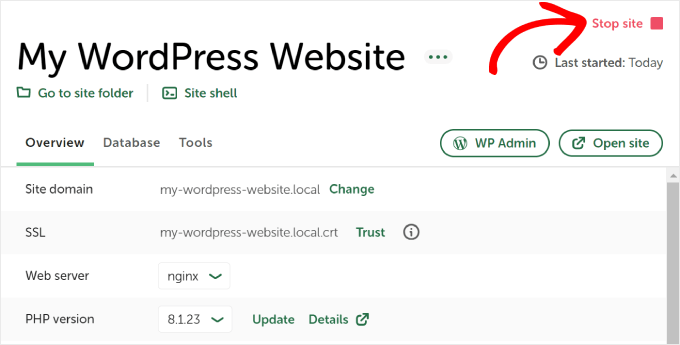
Dica profissional: se quiser ignorar o processo de login, você pode ativar um login de administrador com um clique no Local WP.
Para fazer isso, basta voltar ao painel do Local WP e alternar o botão “One-click admin” até que ele diga “On”. Em seguida, no menu suspenso, selecione o usuário administrador que pode usar esse recurso de login com um clique.

Alternativa: Use o WordPress Playground para testar temas, plug-ins e muito mais
O WordPress Playground é uma ferramenta inovadora que permite fazer experiências com o WordPress diretamente no navegador da Web. É uma caixa de areia virtual onde você pode experimentar novos temas, plug-ins e recursos do WordPress sem afetar nenhum site real.
O WordPress Playground é diferente de um ambiente local do WordPress em vários aspectos importantes.
Primeiro, ele não requer instalação em seu computador e é redefinido após cada uso, ao contrário das configurações locais permanentes. Você pode acessá-lo de qualquer dispositivo com um navegador, enquanto as instalações locais estão vinculadas a um computador.
Embora o WordPress Playground seja ideal para testes rápidos e aprendizado, um ambiente local do WordPress em seu computador Windows oferece mais flexibilidade para projetos de desenvolvimento de longo prazo.
Para obter um passo a passo detalhado, consulte nosso guia sobre como usar o WordPress Playground em seu navegador.
Instalei o WordPress em meu computador Windows, e agora?
Agora que você tem o WordPress em seu computador, aqui estão algumas coisas que você pode fazer:
- Aprenda dicas e truques básicos do WordPress para usar melhor seu site.
- Experimente diferentes temas do WordPress para ver como seu site pode ficar.
- Instale e teste os plug-ins obrigatórios do WordPress para adicionar novos recursos ao seu site.
- Saiba como corrigir erros comuns do WordPress por conta própria.
- Experimente diferentes construtores de páginas do tipo arrastar e soltar para deixar seu site mais bonito.
- Saiba como redefinir a senha de administrador do WordPress no localhost para recuperar o acesso ao seu site.
- Configure fluxos de trabalho automatizados para facilitar o gerenciamento de seu site.
- Saiba mais sobre a segurança do WordPress para manter seu site protegido contra hackers.
- Mova seu site local do WordPress para um servidor ativo quando estiver pronto para compartilhá-lo com todos.
Esperamos que este artigo o tenha ajudado a aprender como instalar o WordPress localmente em um computador Windows. Talvez você também queira ver nosso artigo sobre como instalar o WordPress localmente em um computador Mac e nosso guia definitivo para criar um site de teste do WordPress.
Se você gostou deste artigo, inscreva-se em nosso canal do YouTube para receber tutoriais em vídeo sobre o WordPress. Você também pode nos encontrar no Twitter e no Facebook.





Pulkit
Thank you so much for this tutorial, it will surely help me a lot
Dubba Ramesh
Very nice tutorial.
its very use full to me..
thank you very much…..
Pradeep
Thank you very much. I was facing trouble earlier doing it and here detailed yet simple steps lead me to finish it. Great work keep doing it.
alex
hi
i do it like u.
but when i fiill everu thing and wana to go to next page to finish set uo the page is wite and dosnt show any thing !!!
i can see the admin page : 127.0.0.1/wp-login.php but the username and password dosnt work !!
what do i do ??
thx
Yvonne
Need help please….
I’ve downloaded wamp and did some set up (followed other instructions on youtube), it is now “online” but when I tried to access phpMyAdmin, it says “#1045 – access denied for user ‘root’@’localhost’, can anyone give me some advice, please?
Thank you so much!!!
sarvesh maurya
I have install wamp server and my wordpress also works very well,
But,
When i going to install any theme or plugin to my wordpress it doesn’t install properly and showing error message in table form which is not understandable for me…………
solve this problem please…….
it is very important……
REPLY FAST PLEASE….
WPBeginner Support
What error message do you see?
Admin
Skippy McGregor
If you’re having issues with this, run WAMP as an administrator (right click from start menu > run as administrator). The icon in the notification area needs to be green.
John
Thank you, I am using Sitegorund servers, but it was very nice to learn how to work offline!
Marcia
Three years ago, I spent days of my life trying to get WordPress running on my computer. I managed to make it work, but the process was very, very painful.
This time around, I followed your concise, clear and excellent instructions. The result: quick and pain-free success. Thank you !!!
WPBeginner Support
Thanks for the feedback. Glad you found this helpful.
Admin
Wayne
Hi there, Worked great. I did find that I was getting a 404 when trying to view the site localhost/mysite/ but when I tried in Chrome Incognito it worked fine. Also, it appears that the configuration file is now created automatically while using WordPress 4.4.1.
Thanks for the tutorial.
Andrew
I’ve installed wordpress into the www folder, Apache is running but when I try with localhost/worpress/ we get a 404 error, how can we fix this?
Tunde
Thank you very much for this tutorial. It works perfectly.
René Rijlart
Helpfulllllll
Chris
I hate this open source garbage. I can never get it to work. I follow the freaking examples perfectly, and I get all kinds of errors and stuff doesn’t work… WordPress and WAMP is freaking CRAP!!!
Peter
Funny comment … Just followed the instructions, downloaded WordPress, and reached the Dashboard. Everything worked smoothly and quickly — five minutes at most. And I am 80 years old — by rights I should be the one to have been lost …
samar
thanks
it’s helpful
Ryan
Sorry, I need a wp-config-sample.php file to work from. Please re-upload this file to your WordPress installation.
How can I resolve this. I have edited and renamed the wp-config.php file but things cant just work for me. Its been two days now. I cant make progress
WPBeginner Support
Download a fresh copy of WordPress to your computer. Unzip the file and then go to WordPress folder. Inside the folder you will find wp-config-sample.php file. You can now upload this file to your website using an FTP client.
Admin
Chris
Hi guys, I also had an issue with the getting a 404 error and permission error. I misinterpreted the text so in case anyone else has done the same let me paraphrase the following paragraph:
“Download a copy of WordPress from WordPress.org. Extract the zip file and copy the wordpress folder. Go to C:\wamp\www and paste wordpress folder there. You can rename the wordpress folder to anything you want for example mysite, wpbeginner, etc”
1) After installing WAMP, in the windows GUI navigate to ‘C:/wamp/www’
2) The drop the extracted WordPress folder (not just the loose files).
I was doing it wrong; I was dropping the loose files from inside WordPress into the www folder and changing the name. It seems this is incorrect.
Enjoy!!
Chris
I installed WAMPServer, clicked on phpMyAdmin, then in the browser I got:
Server Error in ‘/’ Application.
Access is denied.
Description: An error occurred while accessing the resources required to serve this request. The server may not be configured for access to the requested URL.
Error message 401.2.: Unauthorized: Logon failed due to server configuration. Verify that you have permission to view this directory or page based on the credentials you supplied and the authentication methods enabled on the Web server. Contact the Web server’s administrator for additional assistance.
Version Information: Microsoft .NET Framework Version:4.0.30319; ASP.NET Version:4.0.30319.34274
tomi
Hello
When I run http://localhost/mysite/ I get a 404 error. I have no idea how to fix it and could use some help:)
Screenshoted issue: http://prntscr.com/9ft5z6
Thanks in advance!
WPBeginner Support
Make sure apache is running on your computer. If you are using Wamp or Xamp then you can see apache status in your taskbar.
Admin
Sohail Nawaz
thankyou very much.
Soph Desharnais
Great tutorial. No issues and was set up in less than 10 minutes. Thank you.
Tasneem
Hi
Thank you sooo much for this awesome tut, I also have the followup one bookmarked for moving localhost site to live. I am now all set up with my test site on my local server. No more building websites with a maintenance plugin needed!
My question is, do I have to create a new database and new wordpress site for every new site I build, or can I just clean out and reuse this same test_db and localhost/testsite that I created if I don’t need it anymore? what do you guys do?
WPBeginner Support
It is better to create a new test site for any new project.
Admin
Nadia
Hello, thank you for that great tutorial! It works almost perfectly for me. The only problem I have is that I am not allowed to upload images by grad and drop in the media library. I’ve got javascript error “Uncaught TypeError: Cannot read property ‘appendChild’ of null – load-scripts.php:22”
That said it’s not a problem of the upload itself because I am able to upload images via “Media” > “Add New”.
Is it only my problem? I’ll be really grateful for any assistance with it. Thanks!
WPBeginner Support
Please try deactivating all plugins and then adding an image using drag and drop. If this resolves your issue, then one of the plugins installed on your site is conflicting with WordPress core.
Admin
Nadia
Thank you for the prompt reply! NO plugins at all, fresh wp 4.3.1 installation
Nadia
I resolved this by installing XAMPP instead of Wampserver. I had issues with XAMPP as well, and learned to run it as administrator in my Windows 8. It fixed the issues and maybe there was the similar one with the Wampserver.
Anwar Manha
Hi
I tried the exact step but thrown by the below error, could you please advise
( ! ) Warning: require(C:\wamp\www\test1/wp-includes/load.php): failed to open stream: No such file or directory in C:\wamp\www\test\wp-settings.php on line 21
Call Stack
Daniel
Hi, i have made a website using the WAMP-server.
When try to acess the website from my phone to check the responsivness, all i get is the the text from the website. No styling or pictures are shown.
Is there any type of settings that i have to enable?
John van Rems
Maybe I’m stupid but after installing the Wampserver I try to open phpMyAdmin to setup a database but instate of getting a page like the example the browserpage is empty… Logic I guess because Apage doesn’t run so I can’t see php pages on a local machine.
I try to run it on Windows 10 Can you tell me what’s wrong?
John
John van Rems
Problem solved by correcting te Windows 10 Internetport to 8080
Now to find out how to connect the php db to my wordpress
tsega
hi
Nice post. I find it helpful but i wonder how can i use my own them. Can you give as your expertise on that ?
Keith in Winchester
A full day of headbanging and I was just about to give up when I found this invaluable site. Could not have been made easier. Follow the well laid out instructions and you will find it a breeze. Great work and Many Thanks.
Medha
Thank you so much, this really helped!
John
Hi,
I followed all the instructions up to the point where i go through my web browser to localhost/mysite. I get the error “wp-seetings.php is missing” however the link you provided to create a configuration file is empty. How do i create “wp-settings.php”?
Thanks
Ahsan
Thanks guys, it was surely a great help!
sandeep
thank you so much. very good tutorial.
Mike
This is a real beauty! Thanks so much. I know HTML, CSS, JavaScript, PHP, a very little MySQL — no genius at some of it, but I know what I’m doing. But an organization I’m involved with may wind up using WordPress and I’ve never liked these WYSIWYGs. Since I do want to learn the stuff, though, I wanted to give it a swing on localhost rather than messing up my own GoDaddy- and Netfirms-hosted domains.
Just follow your directions and this installs beautifully. One question, though. Is there any particular book you’d recommend? I was particularly looking at the Dummies All-in-One and the Missing Manuals books. Is one better than the other? Or do you recommend a third alternative? I don’t want to buy a whole library full of this stuff for a technology I may never use that much except for helping this organization with upkeep.
WPBeginner Support
Check out WordPress Books section on our website.
Admin
Liana
after I click on the phpadmin all I get is a blank page with nothing on it :/
raydy
Hi There, Thanks for the tutorial
however, i encounter with this problem for localhost/mysite/
Not Found
The requested URL /mysite/ was not found on this server.
Apache/2.4.9 (Win32) PHP/5.5.12 Server at localhost Port 80
Alok
Hi,
I am also facing the same problem…Did you get the solution? Can you please help.
Regards,
Alok
Mike
Thumbs up mate,
Great guide…it was very helpful!
Julian
Please help. This is what I get:
“Not Found
The requested URL /mysite/ was not found on this server.
Apache/2.4.9 (Win64) PHP/5.5.12 Server at localhost Port 80”
I took my wordpress folder and dropped it in the wamp folder, C:\wamp\www. I renamed my wordpress folder to: “mysite”. I then went to Chrome and searched: “localhost/mysite/”. And I get:
“Not Found
The requested URL /mysite/ was not found on this server.
Apache/2.4.9 (Win64) PHP/5.5.12 Server at localhost Port 80.”
Kyle
Burnt out. Seriously. Help.
No manner of step by step instruction is working and I’m pulling out my hair. What am I missing?
“Download a copy of WordPress from WordPress.org. Extract the zip file and copy the wordpress folder. Go to C:\wamp\www and paste wordpress folder there. You can rename the wordpress folder to anything you want for example mysite, wpbeginner, etc. For the sake of this tutorial, we renamed our wordpress directory to mysite. Now open a web browser and go to:
http://localhost/mysite/”
C:\wamp\www ???
First off, there is no folder titled “www,” so maybe you’re implying the website name take that place? I don’t really know.
Still, I tested all methods. I tried creating a folder called ‘www,’ I tried simply C:\mamp\sitename, But when I type in the “localhost/sitename” absolutely nothing happens.
I have experience doing website redesigns and all I want to do is clone this site to my local host and I am baffled at how I’ve spent 2 whole days just trying to get WordPress isn’t even installed on my local host.
Thank you in advance.
Composed under duress.
Captain
Hello Kyle, sorry for your sad experience.
You said you don’t see a folder called “www” on C:\wamp.
Can you check to confirm that you have wampserver installed on your computer?
Also, it could be it’s installed but not on the C drive.
Do get back when you confirm; cos the tutorial was quite straight and worked really well for me.
aman
After installing WAMP server and clicking on phpmyadmin there is an error that says Access Denied and no other option is displayed. Please Help me
DutchLuck
Great tutorial, sweet and simple!!! Thanks!!!
Karthikeyan
Good Example.Its working fine for me.
Thank you all..
Janvi
hi
i m not getting create configuration file option
WPBeginner Support
Your WordPress folder may already have a wp-config.php file. This file may not have correct information for your WordPress database settings. Please see our guide on editing wp-config.php file in WordPress.
Admin
Samantha T
Sooooooooooooooooooooo… I uninstalled everything and reinstalled. Now I have an orange light on the Wamp, and when I open phpMyAdmin, I get “Access denied”: MySQL said: Documentation
#1045 – Access denied for user ‘root’@’localhost’ (using password: NO)
phpMyAdmin tried to connect to the MySQL server, and the server rejected the connection. You should check the host, username and password in your configuration and make sure that they correspond to the information given by the administrator of the MySQL server.
*sigh*
Joe
OK, how do you do that?
odion
After installation of wordpress in my computer, I did not receive a success message but a blank white page and am not able to login into the wp-admin.
odion ikhidero
Pls I got. The following errors after installation
Sansun
I already have MySQL server running in my local 3306 port, how do I install WAMP in my case?
Aamir
Thanks for the help.
I have been taking help from your immensely helpful site. It is a great service that you guys are providing.
Jim14409
Hi, )
)
Thanks for your site and all the help you offer. I installed WAMP and everything went perfectly until I reached the part where you said:
“WordPress will inform you that it can not find a wp-config.php file.”
Well WP never said that :0 but sent me directly to a Directory of “JimSite” with links there to Parent Directory and a link to WordPress. Finally clicked the WordPress link and now it seems we are heading to the config-php setup. (I’ll holler back if the trail dead-ends
Thought you might want to amend your guide with a note about this possibility for some users so as to save them the confusion and frustration I’ve had the past half hour. Might have something to do with my using Vista64, I’m not sure.
Thanks again and for your nice email when I signed up.
Jim
Markus
Thanks for this nice tutorial. Its really helpful, and works like a charme to set up.
The skype addition about the port issue with wamp helped me also – sometimes wamp just wouldn’t work and I didn’t know why. (I’m using skype just once in a while..)
I’ve got another question though: How to move a live website to localhost for development.
I’m not really sure how to go about it. Copy everything (including db) and change the settings in the config file of wordpress. or install wordpress and then migrate the database somehow, and add the other special content…
WPBeginner Support
See how to move a live WordPress site to local server.
Admin
Samuel
Thanks
But I have an issue. After installation, I got a prompt “The program can’t start because MSVCR110.dll is missing from your computer, Try reinstalling the program to fix the problem”
What do I do?
Dev Enthusiast
Hi Samuel,
The error that you received can be fixed by downloading and installing the following from Microsoft:
Visual C++ Redistributable
Give that a try!